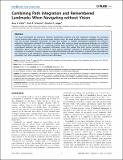| dc.contributor.author | Schrater, Paul R. | |
| dc.contributor.author | Legge, Gordon E. | |
| dc.contributor.author | Kalia, Amy Ashwin | |
| dc.date.accessioned | 2013-09-30T12:28:33Z | |
| dc.date.available | 2013-09-30T12:28:33Z | |
| dc.date.issued | 2013-09 | |
| dc.date.submitted | 2013-01 | |
| dc.identifier.issn | 1932-6203 | |
| dc.identifier.uri | http://hdl.handle.net/1721.1/81226 | |
| dc.description.abstract | This study investigated the interaction between remembered landmark and path integration strategies for estimating current location when walking in an environment without vision. We asked whether observers navigating without vision only rely on path integration information to judge their location, or whether remembered landmarks also influence judgments. Participants estimated their location in a hallway after viewing a target (remembered landmark cue) and then walking blindfolded to the same or a conflicting location (path integration cue). We found that participants averaged remembered landmark and path integration information when they judged that both sources provided congruent information about location, which resulted in more precise estimates compared to estimates made with only path integration. In conclusion, humans integrate remembered landmarks and path integration in a gated fashion, dependent on the congruency of the information. Humans can flexibly combine information about remembered landmarks with path integration cues while navigating without visual information. | en_US |
| dc.description.sponsorship | National Institutes of Health (U.S.) (Grant T32 HD007151) | en_US |
| dc.description.sponsorship | National Institutes of Health (U.S.) (Grant T32 EY07133) | en_US |
| dc.description.sponsorship | National Institutes of Health (U.S.) (Grant F32EY019622) | en_US |
| dc.description.sponsorship | National Institutes of Health (U.S.) (Grant EY02857) | en_US |
| dc.description.sponsorship | National Institutes of Health (U.S.) (Grant EY017835-01) | en_US |
| dc.description.sponsorship | National Institutes of Health (U.S.) (Grant EY015616-03) | en_US |
| dc.description.sponsorship | United States. Department of Education (H133A011903) | en_US |
| dc.language.iso | en_US | |
| dc.publisher | Public Library of Science | en_US |
| dc.relation.isversionof | http://dx.doi.org/10.1371/journal.pone.0072170 | en_US |
| dc.rights | Creative Commons Attribution | en_US |
| dc.rights.uri | http://creativecommons.org/licenses/by/2.5/ | en_US |
| dc.source | PLoS | en_US |
| dc.title | Combining Path Integration and Remembered Landmarks When Navigating without Vision | en_US |
| dc.type | Article | en_US |
| dc.identifier.citation | Kalia, Amy A., Paul R. Schrater, and Gordon E. Legge. “Combining Path Integration and Remembered Landmarks When Navigating without Vision.” Edited by Marc O. Ernst. PLoS ONE 8, no. 9 (September 5, 2013): e72170. | en_US |
| dc.contributor.department | Massachusetts Institute of Technology. Department of Brain and Cognitive Sciences | en_US |
| dc.contributor.mitauthor | Kalia, Amy Ashwin | en_US |
| dc.relation.journal | PLoS ONE | en_US |
| dc.eprint.version | Final published version | en_US |
| dc.type.uri | http://purl.org/eprint/type/JournalArticle | en_US |
| eprint.status | http://purl.org/eprint/status/PeerReviewed | en_US |
| dspace.orderedauthors | Kalia, Amy A.; Schrater, Paul R.; Legge, Gordon E. | en_US |
| mit.license | PUBLISHER_CC | en_US |
| mit.metadata.status | Complete | |
